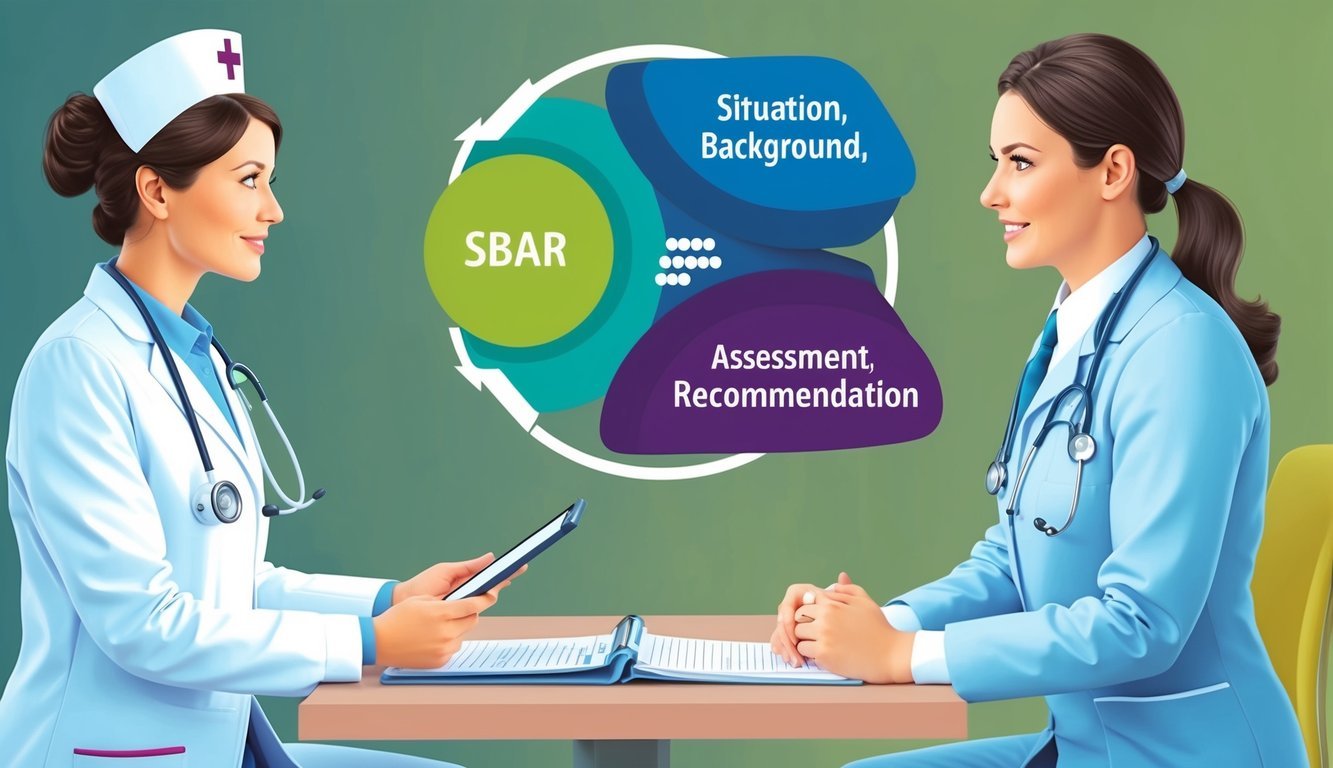Effective communication in nursing is essential for providing high-quality patient care. SBAR is a structured communication tool that helps nurses and healthcare providers convey critical information clearly and efficiently.
By breaking down complex patient data into manageable categories—Situation, Background, Assessment, and Recommendation—SBAR enhances understanding among team members and supports patient safety.
In today’s fast-paced healthcare environment, you need reliable methods to communicate vital information quickly.
SBAR not only improves teamwork but also aids in clinical decision-making, ensuring that you have the information needed to take appropriate actions for your patients.
As you explore this article, you will discover practical insights into implementing SBAR in your nursing practice.
Whether you are new to nursing or looking to enhance your skills, understanding how to use SBAR can significantly impact your role in patient care.
This article will guide you through the foundations of SBAR and its benefits for effective communication among healthcare teams.
Key Takeaways
- SBAR improves clarity in patient communication among healthcare providers.
- Effective use of SBAR enhances patient safety and care outcomes.
- Implementing SBAR fosters teamwork and supports clinical decision-making.
Foundations of SBAR
SBAR is a structured communication tool that enhances clarity in healthcare settings.
It stands for Situation, Background, Assessment, and Recommendation.
Understanding its origins and key components can improve your communication with colleagues and ensure patient safety.
Origins and Importance of SBAR
SBAR was developed in the 1990s by the U.S. Navy as a tool for improving communication.
Its purpose was to enhance the transmission of critical information among team members.
In healthcare, SBAR has gained recognition for fostering clear and concise communication.
It reduces the risk of misunderstandings, making it easier for you to convey essential patient details.
The significance of SBAR is evident during handoff situations, where clear exchanges can improve patient safety and care quality.
You can learn more about its effectiveness in practice through resources like Nursing Process.
Key Components
The SBAR framework consists of four key components:
-
Situation: Describe the current situation. Include who you are, your patient’s name, and the main issue at hand.
-
Background: Provide relevant background information, such as the patient’s medical history or recent changes in condition.
-
Assessment: Share your assessment findings, which might include vital signs and other clinical observations.
-
Recommendation: Suggest what you believe should happen next. This might involve asking for a specific action or further assessment.
Using SBAR helps organize your thoughts and clearly communicate your needs.
It prepares you for effective discussions with your team and other healthcare professionals.
You can find more insights about using SBAR in nursing at Simple Nursing.
Implementation in Nursing Practice
Implementing SBAR in nursing practice enhances communication among health professionals.
It provides a structured approach to transferring vital patient information.
This method is essential during shift changes and handovers, ensuring safe and effective care.
Integrating SBAR in Nursing Workflow
To successfully integrate SBAR into your nursing workflow, you should first receive training on its components: Situation, Background, Assessment, and Recommendation.
Next, consider creating visual aids in your workspace.
For example, posting SBAR templates in staff areas can serve as reminders for effective communication.
Here’s a quick guide to each component:
| SBAR Component | Description |
|---|---|
| Situation | Briefly state the issue or concern. |
| Background | Provide relevant patient history. |
| Assessment | Share your assessment of the situation. |
| Recommendation | Suggest a course of action. |
Regular practice and feedback will help staff use SBAR effectively.
Encourage team members to ask questions and participate in role-playing exercises.
SBAR for Shift Changes and Handovers
Using SBAR during shift changes and handovers is critical for patient safety.
Start each handover with clear communication of the patient’s situation.
Ensure you cover these key points during the handover:
- Updates on the current condition of the patient.
- Changes in treatment plans or medications.
- Patient concerns that need attention.
This structure not only clarifies patient status but also allows for a smoother transition between shifts.
A recent study showed that using SBAR improved nurse satisfaction and reduced miscommunication.
When all staff are familiar with the SBAR method, patient care continuously improves.
Consider implementing a buddy system to help new nurses familiarize themselves with SBAR.
This will encourage a culture of open communication among your health professionals.
Enhancing Communication Among Healthcare Teams
Effective communication is key to creating a strong healthcare team.
You can achieve better teamwork and collaboration by implementing structured methods like SBAR.
Sharing critical information in a clear manner also plays a vital role in patient safety and care quality.
Teamwork and Collaboration
Teamwork among healthcare professionals is crucial for improving patient outcomes.
When you work closely with other members of your team, you build trust and understanding.
This helps in coordinating care more efficiently.
Using tools like SBAR allows you to present relevant information systematically.
This structured approach enhances collaboration by making it easier for each team member to contribute.
Key components of effective teamwork include:
- Open communication: Encouraging everyone to voice their thoughts.
- Respectful interactions: Valuing each team member’s input.
- Defined roles: Knowing your responsibilities helps streamline processes.
Implementing these elements strengthens relationships within the healthcare team and leads to better patient care.
Sharing Critical Information
Sharing critical information effectively is essential for safe patient care.
You must ensure that vital details are communicated accurately and promptly.
This can prevent misunderstandings that may lead to errors.
The SBAR technique (Situation, Background, Assessment, Recommendation) plays a significant role here.
It helps you present complex information in a simple format, making it more digestible for your colleagues.
For example:
- Situation: What is happening right now?
- Background: What has led to this situation?
- Assessment: What do you think about the situation?
- Recommendation: What should be done next?
When all team members use this structured method, communication improves significantly, leading to better patient outcomes.
You can reference resources on SBAR in nursing for more details.
SBAR in Clinical Decision-Making
SBAR is a vital communication tool that enhances decision-making in clinical settings.
It allows healthcare professionals to convey important information about patient status clearly and efficiently.
In emergency situations, its structured approach is particularly beneficial, leading to improved patient outcomes.
Application in Emergency Situations
In emergency situations, quick and accurate communication is crucial.
Using SBAR helps you provide essential details about the patient’s condition rapidly.
The structure of SBAR allows you to present:
- Situation: Briefly state the immediate concern.
- Background: Offer relevant medical history.
- Assessment: Share your findings from examinations.
- Recommendation: Suggest a course of action.
This method streamlines your thought process.
It encourages critical thinking and ensures that all team members understand the urgency of the patient’s condition.
As a result, timely interventions can be implemented, which is crucial for patient survival.
Influence on Patient Outcomes
Effective use of SBAR can significantly improve patient outcomes.
When you communicate clearly, the likelihood of misunderstandings decreases.
This clarity leads to better decision-making and quicker response times.
When all team members are on the same page, the overall care provided becomes more efficient.
In studies, it has been shown that hospitals using SBAR see reduced error rates in clinical decisions.
This is because structured communication supports comprehensive assessments.
Lower error rates lead to fewer complications, which directly impacts recovery rates and patient satisfaction.
By implementing SBAR, you foster a culture of open communication, ultimately benefiting patient care and safety.
For further reading on how SBAR affects nursing practice, you can visit this resource.
Optimizing Patient Care and Safety

Effective communication is essential in nursing to enhance patient care and ensure safety.
The use of structured tools like SBAR plays a significant role in minimizing risks and enhancing quality care.
The sections below detail how SBAR can reduce adverse events and support vital signs monitoring.
Reduction of Adverse Events
Using SBAR improves communication during handoffs, which is crucial for patient safety.
This structured approach helps to present clear and concise information, reducing misunderstandings.
Key elements include:
- Situation: Define the current patient issue clearly.
- Background: Offer necessary context about the patient’s history.
- Assessment: Summarize your clinical findings.
- Recommendation: Clearly state what actions should be taken next.
Studies show that implementing SBAR can lead to a significant reduction in adverse events, as it helps healthcare providers make informed decisions quickly.
By enhancing communication, you reduce the likelihood of errors that could harm patients.
Quality Care and Vital Signs Monitoring
Monitoring vital signs is a cornerstone of quality care.
Regular assessment can help detect changes in a patient’s condition early.
When using SBAR, make sure to include vital sign data during discussions.
Considerations include:
- Frequency of Monitoring: Establish a timeline for checking vital signs based on each patient’s needs.
- Documentation: Keep meticulous records of all vital signs and changes.
- Team Communication: Ensure all team members are informed about the patient’s status.
By effectively incorporating vital signs into the SBAR framework, you can foster a culture of continuous quality improvement.
This not only enhances patient outcomes but also strengthens teamwork and accountability among healthcare providers.
For more information on best practices, visit resources like the Institute for Healthcare Improvement.
Frequently Asked Questions

SBAR is a structured communication tool that enhances clarity in nursing practices.
Understanding its components and implementation can greatly improve patient safety and communication among healthcare professionals.
What are the four components of the SBAR communication framework?
The SBAR framework is made up of four key components:
- Situation: Briefly state the current issue or concern.
- Background: Provide relevant background information.
- Assessment: Share your assessment of the situation.
- Recommendation: Suggest a course of action or what you need.
How can SBAR be implemented in clinical nursing practice?
You can implement SBAR by integrating it into handoff reports, interactions with physicians, and during emergency situations.
Training sessions can help familiarize staff with the framework.
Using SBAR consistently is key to improving communication within your team.
Why is SBAR an important tool for patient safety and communication in healthcare?
SBAR improves communication by providing a clear and concise way to convey vital information.
This structure reduces the chance of misunderstandings and enhances collaboration between healthcare providers.
Effective communication is essential for ensuring patient safety and improving care outcomes.
Can you provide an example of an SBAR scenario in nursing?
Certainly! Here’s a basic example:
- Situation: “I’m calling about Mrs. Johnson, a 72-year-old with pneumonia.”
- Background: “She was admitted two days ago and was on IV antibiotics.”
- Assessment: “Currently, she appears more lethargic and her oxygen levels are dropping.”
- Recommendation: “I recommend we consider adjusting her medication or increasing oxygen support.”
What information is crucial to include when a nurse is using the SBAR technique?
When using SBAR, crucial information includes patient identifiers (name, age), specific details of the situation, relevant medical history, and any observations that could impact treatment decisions.
Providing clear and focused data is important for effective communication.
How does the use of SBAR impact interdisciplinary communication in healthcare settings?
Using SBAR fosters better communication among different healthcare professionals.
It allows for a standardized way to convey important information, ensuring that all team members are on the same page.
This leads to improved decision-making and better patient care outcomes.

